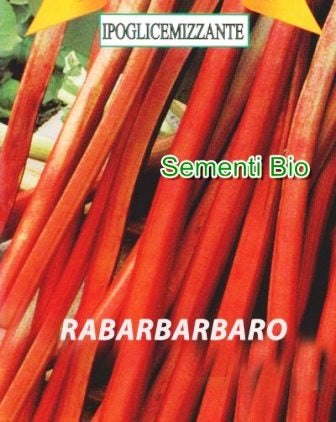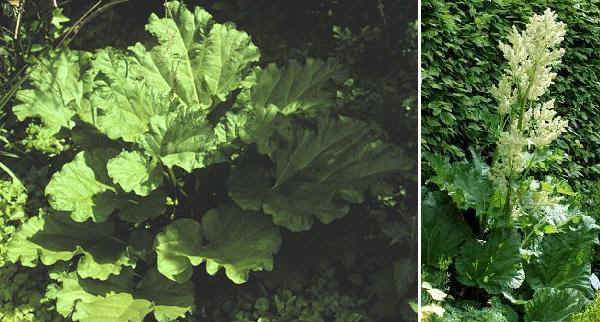Species: Rheum rhaponticum L.
Family: Polygonaceae
Synonym: Rheum rhabarbarum
Generality
Rapontic Rhubarb (or European Rhubarb) is often found in family gardens or even as an ornamental plant; in France and England it is grown as an intensive crop.
The fleshy and succulent leaf stalks with a pleasantly acidic flavor are used to prepare jams; the leaf blades are unusable due to the high content of oxalic acid. The bitter-tasting root is used in liquor and herbalist shops. Dried and reduced to powder, it is used for medicinal purposes (tonic and purgative). The activity of rhubarb is lower than that of Chinese rhubarb ((Rheum palmatum L.) imported for herbal use.
Rhubarb – Rheum rhaponticum L. (photo http://cal.vet.upenn.edu)
Rhubarb seedlings – Rheum rhaponticum L. (photo www.agraria.org)
Botanical characters
Rhubarb is a lively herbaceous plant native to Central Asia (Urals and Caucasus).
Rhubarb forms a robust yellow rhizome with deep roots; from this a rosette of very large oval leaves develops, with a crenate margin. The leaves have a long and thick, cylindrical, grooved, reddish petiole. The flower stem is up to 2 meters high; it has small whitish hermaphroditic flowers gathered in a panicle; pollination is anemophilous; the fruit is a nocula, which is used as a seed. It propagates by seed (in spring) or by division of the rhizomes (in autumn-winter).
Cultivation and biodynamic preparations
There are cultivars with green stalks and red stalks.
It has low thermal requirements and adapts well to cold and humid climates. It resists winter frosts thanks to the rhizome that grows back in spring. It is not very suitable for the hot and dry climates of the South, where it pre-flowers and stops growth. The ideal soils are medium-textured, deep and fresh, with a pH between 5 and 7, not subject to water stagnation.
Before planting, deep tillage is necessary, with distribution of composted manure.
The seedlings or rhizome sections with buds are planted in autumn or early spring at 1.5-2 m between the rows and 1 meter along the row. Cultural care is based on the control of wild herbs and on watering which must be regular; in autumn preparation 500 is administered and in spring 500 and 501.
Collection and conservation
Harvesting begins in the second year, removing the leaf petioles without the edge by hand. Usually a third of the leaves present are left on the plants. The rhizomes can be harvested in the 3-4th year, they are cleaned of the earth, cut into slices and left to dry (60-70 quintals per hectare of dry rhizomes at the end of the cultivation).
Adversity and parasites
It is a rustic plant, subject to few adversities, including leaf attacks by Phillosticta straminella and Colletotrichum erumpens, and those by aphids, easily controlled with the use of nettle macerate.





